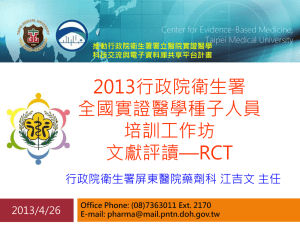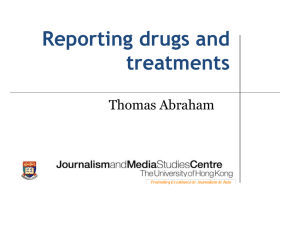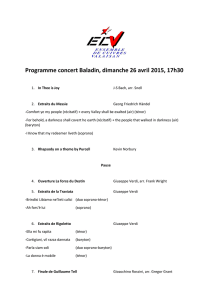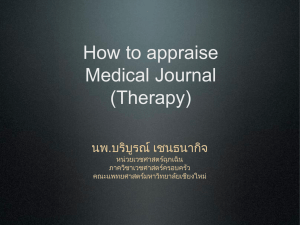Quantifying Treatment Effects
advertisement
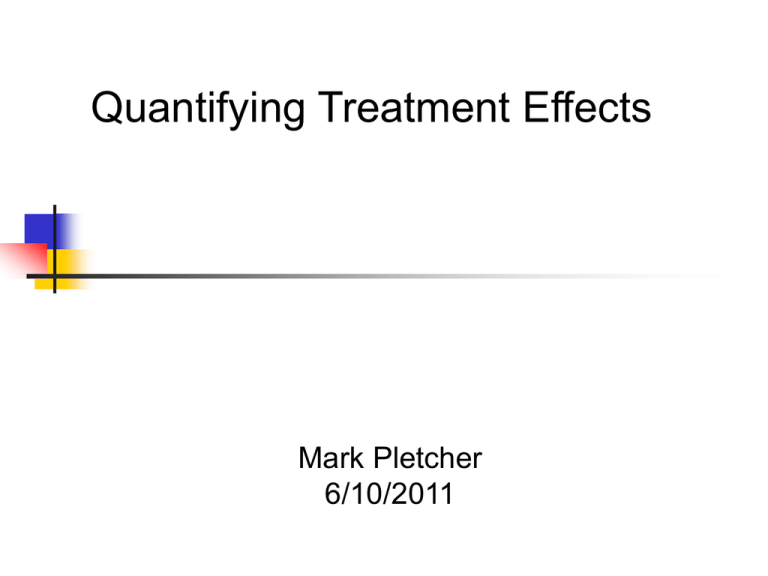
Quantifying Treatment Effects Mark Pletcher 6/10/2011 Rationale Any treatment involves tradeoffs Weigh benefits against risks/costs Benefit $$ Harm Rationale Sometimes the decision is difficult! Benefit $$ Harm Rationale How big is this box? Benefit And this one? $$ Harm Rationale Tests can help us understand who is most likely to benefit from a treatment How big is this box? Benefit And this one? $$ Harm Rationale Tests can help us understand who is most likely to benefit from a treatment Rapid strep to decide who will benefit from penicillin BNP to decide who will benefit from furosemide CRP to decide who will benefit from statins Rationale The utility of a test depends on: How beneficial the treatment is How harmful the treatment is How much the test tells us about these benefits and harms in a given individual Risk of harm from the test itself Rationale The utility of a test depends on: How beneficial the treatment is How harmful the treatment is How much the test tells us about these benefits and harms in a given individual Risk of harm from the test itself The topic for this lecture Outline Is an intervention really beneficial? How beneficial is it? Pitfalls Examples Is the intervention beneficial? Randomized trials compare an outcome in treated to untreated persons MI in 10% vs. 15% Duration of flu symptoms 3 vs. 5 days Is the intervention beneficial? Randomized trials compare an outcome in treated to untreated persons MI in 10% vs. 15% Duration of flu symptoms 3 vs. 5 days *Statistics* are used to decide if should reject the “null hypothesis” and accept that the intervention is beneficial Is the intervention beneficial? But statistics cannot help us interpret effect size Quantifying the Benefit Effect size How do we summarize and communicate this? What is really important for clinicians and policymakers? Quantifying the Benefit Effect size How do we summarize and communicate this? What is really important for clinicians and policymakers? Example: MI in 10% vs. 15% Q: What do we do with these two numbers? Quantifying the Benefit Two simple possibilities: 10% / 15% = 0.66 15% - 10% = 5% Quantifying the Benefit Two simple possibilities: 10% / 15% = 0.66 15% - 10% = 5% Relative Risk (RR) Absolute Risk Reduction (ARR) Quantifying the Benefit Relative risk as a measure of effect size RR = 0.66 – is this big or small? Quantifying the Benefit Relative risk as a measure of effect size RR = 0.66 – is this big or small? MI: Death: Basal Cell CA: 10% vs. 15% in 10 years 50% vs. 75% in 3 years 2% vs. 3% in lifetime Quantifying the Benefit Relative risk as a measure of effect size Medium RR = 0.66 – is this big or small? Big Small MI: Death: Basal Cell CA: 10% vs. 15% in 10 years 50% vs. 75% in 3 years 2% vs. 3% in lifetime Quantifying the Benefit Relative risk as a measure of effect size RR = 0.66 – is this big or small? MI: Death: Basal Cell CA: 10% vs. 15% in 10 years 50% vs. 75% in 3 years 2% vs. 3% in lifetime RR is NOT the best measure of effect size Quantifying the Benefit Absolute risk reduction (ARR) is better ARR = Risk difference = Risk2 – Risk1 Quantifying the Benefit Absolute risk reduction (ARR) is better MI: Death: Basal Cell CA: 10% vs. 15% in 10 years 50% vs. 75% in 3 years 2% vs. 3% in lifetime RR .66 .66 .66 ARR 5% 25% 1% Q: What does the 34% reduction mean? Nimotop® Ad Graph 22% Risk1 = 61/278 = 21.8% Risk2 = 92/276 = 33% RR = 22%/33% = .66 ARR = 33% - 22% = 11% 33% Nimotop® Ad Graph 22% Risk1 = 61/278 = 21.8% Risk2 = 92/276 = 33% RR = 22%/33% = .66 ARR = 33% - 22% = 11% 33% What is 34%? Nimotop® Ad Graph 22% Risk1 = 61/278 = 21.8% Risk2 = 92/276 = 33% RR = 22%/33% = .66 ARR = 33% - 22% = 11% 33% Relative risk reduction (RRR) = 1 – RR = 1-.66 = .34 or 34% Quantifying the Benefit RRR is no better than RR MI: Death: Basal Cell CA: 10% vs. 15% in 10 years 50% vs. 75% in 3 years 2% vs. 3% in lifetime RR .66 .66 .66 RRR 34% 34% 34% Quantifying the Benefit RRR is ALWAYS bigger than ARR (unless untreated risk is 100%) Quantifying the Benefit BEWARE of risk reduction language!! ARR or RRR? “We reduced risk by 34%” “Risk was 34% lower” Quantifying the Benefit BEWARE of risk reduction language!! ARR or RRR? “We reduced risk by 34%” “Risk was 34% lower” can’t tell can’t tell Very hard to be unambiguous! Quantifying the Benefit Another reason that ARR is better: Translate it into “Number Needed to Treat” NNT = 1/ARR Why is NNT = 1/ARR? 100 SAH patients treated 67 no stroke anyway R2 11 strokes prevented R1 22 strokes with Nimotop® 33 strokes with no treatment 22 strokes with with treatment Why is NNT 1/ARR? Treat 100 SAH patients prevent 11 strokes Ratio manipulation: 100 treated = 1 treated = 9.1 treated 11 prevented .11 prevented 1 prevented Why is NNT 1/ARR? Treat 100 SAH patients prevent 11 strokes Ratio manipulation: 100 treated = 1 treated = 9.1 treated 11 prevented .11 prevented 1 prevented 1/ARR = NNT Why is NNT 1/ARR? NNT best expressed in a sentence: “Need to treat 9.1 persons with SAH using nimodipine to prevent 1 cerebral infarction” Quantifying the Benefit NNT calculation practice MI: Death: Basal Cell CA: 10% vs. 15% in 10 years 50% vs. 75% in 3 years 2% vs. 3% in lifetime RR .66 .66 .66 ARR NNT? 5% 25% 1% Quantifying the Benefit NNT calculation practice MI: Death: Basal Cell CA: 10% vs. 15% in 10 years 50% vs. 75% in 3 years 2% vs. 3% in lifetime RR .66 .66 .66 ARR NNT? 5% 20 25% 1% Quantifying the Benefit NNT calculation practice MI: Death: Basal Cell CA: 10% vs. 15% in 10 years 50% vs. 75% in 3 years 2% vs. 3% in lifetime RR .66 .66 .66 ARR NNT? 5% 20 25% 4 1% Quantifying the Benefit NNT calculation practice MI: Death: Basal Cell CA: 10% vs. 15% in 10 years 50% vs. 75% in 3 years 2% vs. 3% in lifetime RR .66 .66 .66 ARR 5% 25% 1% NNT? 20 4 100 Quantifying the Benefit Statins NNT expression practice MI: Death: Chemo Sunscreen Basal Cell CA: every day 10% vs. 15% in 10 years 50% vs. 75% in 3 years 2% vs. 3% in lifetime RR .66 .66 .66 ARR 5% 25% 1% NNT? 20 4 100 Quantifying the Benefit NNT expression practice “Need to treat 20 patients with statins for 10 years to prevent 1 MI” “Need to treat 4 patients with chemo for 3 years to prevent 1 death” “Need to treat 100 patients with sunscreen every day for their whole life to prevent 1 basal cell” Example 1 Randomized controlled trial of the effects of hip replacement vs. screws on re-operation in elderly patients with displaced hip fractures. Parker MH et al. Bone Joint Surg Br. 84(8):1150-1155. Example 1 Re-operation No Re-operation Hip Replacement 12 217 229 Internal Fixation with Screws 90 136 226 Parker MH et al. Bone Joint Surg Br. 84(8):1150-1155. Example 1 Re-operation No Re-operation Risk Hip Replacement 12 217 229 12/229 = 5.2% Internal Fixation with Screws 90 136 226 90/226 = 39.8% Example 1 Re-operation No Re-operation Risk Hip Replacement 12 217 229 12/229 = 5.2% Internal Fixation with Screws 90 136 226 90/226 = 39.8% RR = R1/R2 = 5.2% / 39.8% = .13 RRR = 1-RR = 1-.13 = 87% ARR = R2 – R1 = 39.8% - 5.2% = 34.6% NNT = 1/ARR = 1/.346 =3 “Need to treat 3 patients with hip replacement instead of screws to prevent 1 from needing a re-do operation” Example 2 JUPITER: Randomized controlled trial of high dose rosuvastatin in patients with LDL<130 and CRP>2.0 Ridker et al. NEJM 2008; 359:2195-207 Example 2 Ridker et al. NEJM 2008; 359:2195-207 Example 2 Ridker et al. NEJM 2008; 359:2195-207 Example 2 HR = (R1/R2) (from regression) = .56 RRR = 1-HR = 1-.56 = 44% ARR = R2 – R1 = 1.36 - 0.77 = .59 / 100py* = .0059 / py NNT = 1/ARR = 1/.0059 = 100/.59 “Need to treat 169 patients for a year to prevent 1 CVD event” Or better: “Need to treat 85 patients for 2 years to prevent 1 CVD event” (average treatment duration in trial was 1.9 years) * py = person-years = 169 pys Example 4 Warfarin vs. placebo for atrial fibrillation Warfarin Placebo Risk of major bleed (/yr) 1.2% 0.7% Ann Intern Med 1999; 131:492-501 Example 4 Warfarin vs. placebo for atrial fibrillation RR = R1/R2 = 1.2% / .7% = 1.7 RR (flipped) = R2/R1 = .7% / 1.2% = .59 RRR (flipped) = 1-RR = 1 - .59 = 41% ARR = .7% - 1.2% = -.5% = R2 – R1 “ARI” – Absolute risk increase = 0.5% NNT = 1/ARR = 1/-.5% = -200 “NNH” – Number needed to harm = -NNT = 1/ARI = 200 “If you treat 200 Afib patients with warfarin, you will cause 1 major bleed” Circling back to test utility… Tests help determine: If the RR applies Treatment for a disease doesn’t help if you don’t have the disease! Interactions (RR is higher or lower than average) Statins more effective if CRP is high? Patients with gene XYZ more likely to have a side effect Baseline risk The higher the risk, the larger the ARR, the smaller the NNT Key Concepts Test utility depends on how good the treatment is RR and p-values good for hypothesis testing/statistics ARR and NNT (and NNH) better for interpreting clinical importance ARR = risk difference NNT = 1/NNT Beware RRR and ambiguous language
